Z68 SSD Caching with Corsair's F40 SandForce SSD
by Anand Lal Shimpi on May 13, 2011 3:06 AM ESTAnandTech Storage Bench 2011 - Light Workload
Our new light workload actually has more write operations than read operations. The split is as follows: 372,630 reads and 459,709 writes. The relatively close read/write ratio does better mimic a typical light workload (although even lighter workloads would be far more read centric).
The I/O breakdown is similar to the heavy workload at small IOs, however you'll notice that there are far fewer large IO transfers:
| AnandTech Storage Bench 2011 - Light Workload IO Breakdown | ||||
| IO Size | % of Total | |||
| 4KB | 27% | |||
| 16KB | 8% | |||
| 32KB | 6% | |||
| 64KB | 5% | |||
Despite the reduction in large IOs, over 60% of all operations are perfectly sequential. Average queue depth is a lighter 2.2029 IOs.
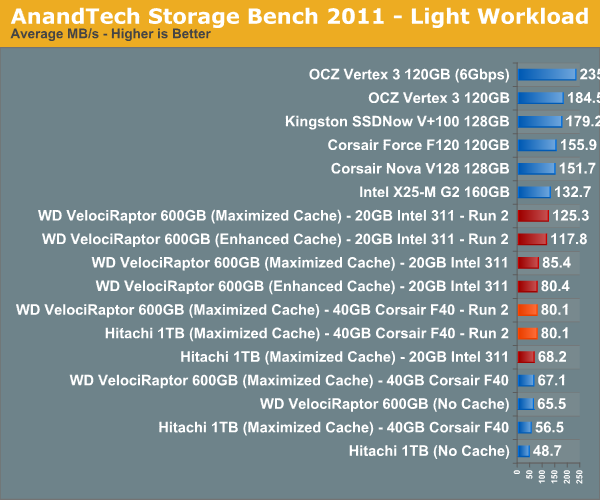
Our light workload doesn't do very well on the F40 at all. As we discovered in our launch review, the heavy workload runs for long enough (~3 hours) that performance doesn't change from run to run. Our light workload however only takes around 30 - 45 minutes to run and thus we see a significant performance difference from one run to the next (after 2 runs the performance gains level off though). While the Intel SSD 311 climbs significantly in both runs, the F40 shows a marginal improvement in the first run and tops out at around 80MB/s regardless of what HDD it's paired with. Clearly we're hitting a bottleneck here, one that doesn't exist on the 311.
An obvious benefit of Intel's SSD 311 is that its firmware was designed with caching in mind, something that isn't true for standard SSDs used as a cache.
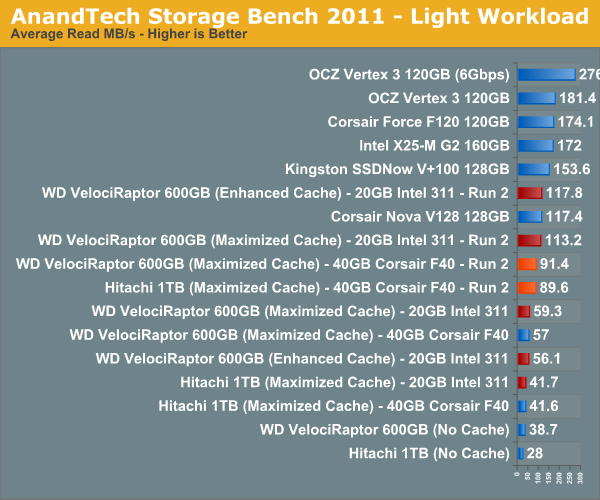
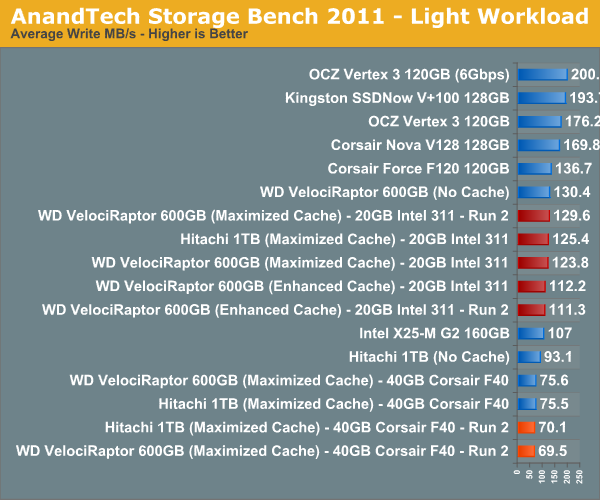
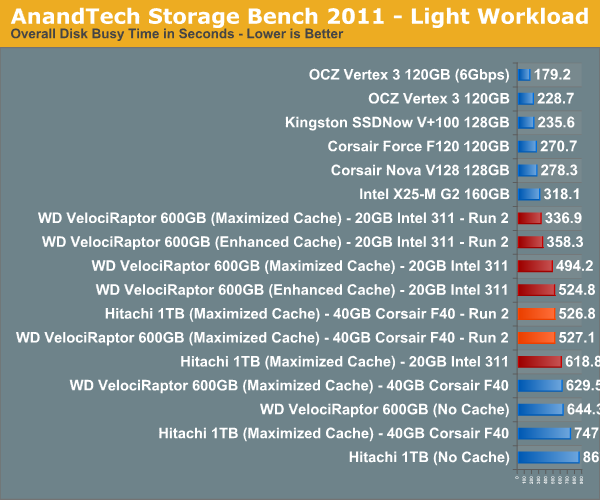
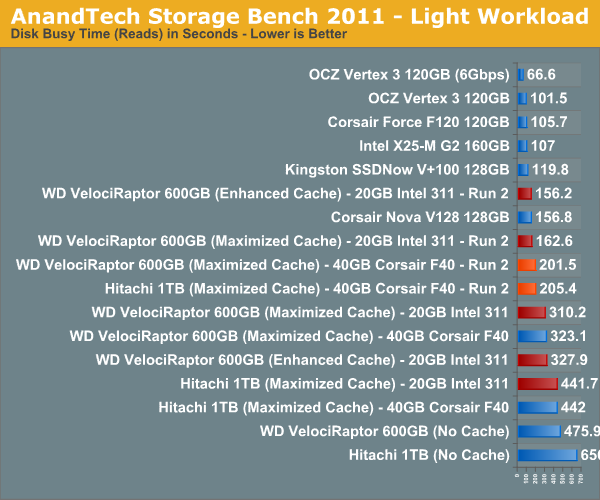
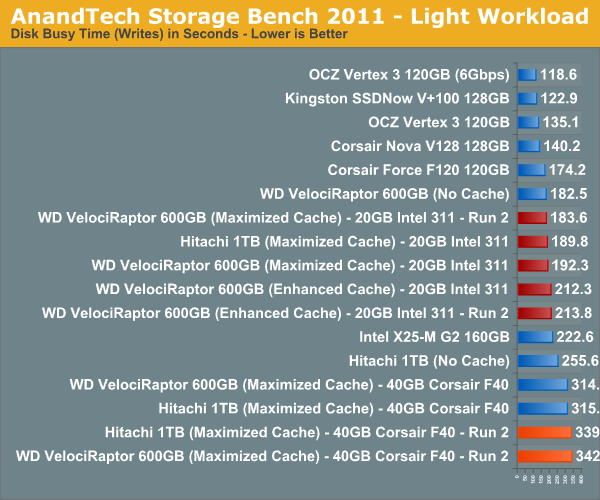










81 Comments
View All Comments
Andreos - Saturday, May 14, 2011 - link
I don't do transcoding and I think the Z68 Virtu hoopla is a one gigantic snooze. None of that is going to save me from having to buy a decent discrete video card.SSD caching is the one thing that sparked my interest in Z68. But the Z68 boards that are coming available online have a price premium over the equivalent P67 board of about $50. An SSD 311 runs $110. That puts you at $160 just to get into the SSD caching game. I'd rather take that $160, kick in another $50, and get a P67 board and a real 120GB SSD. In fact, that's just what I'm going to do!
BTW the Z68 boards have fewer USB ports than the equivalent P67 boards (all those video ports for the integrate video take up real estate).
I think Z68, rather than being frosting on the Sandy Bridge cake, is more like melted ice cream.
Addikt - Saturday, May 14, 2011 - link
After reading these two articles, I don't fully understand what the point of this technology is. I understand that it fills a current void, but how useful is it going to be down the road?With the costs of SSDs continually dropping, and mainstream drive performance increasing, it looks like it will only be 6 months to a year before this technology is obsolete.
It was already highlighted in the previous article that if you have a Vertex 3, you really have no need for this feature. So, in the interim it's bringing SSD-ish performance to mechanical drives, but to what end? Why not just save up your pennies and buy that Vertex 3 that you've always wanted? I mean, this Intel 311 20 GB is going to cost you $100+ anyway.
I just don't see the end-game with respect to this tech. That said, upon reading the comments section, it seems that everyone is so delighted by its arrival, which causes me to question my own understanding of it.
Am I missing something here? Anyone care to enlighten me? I just don't see this as being a really big deal.
slyck - Saturday, May 14, 2011 - link
I feel the same. From the first announcements this looked pretty weak to me. You do get some performance gains but at what cost? Not interested. At all. Waiting til the end of the year to finally make a first SSD purchase(if the prices FINALLY become reasonable. Planned to make first purchase same time last year and the year before.)Pay less for a non-Z68 chipset, save the cost of this overpriced 20GB SSD, and just get a decent sized SSD instead.
xineis - Sunday, May 15, 2011 - link
Intel SSD Caching seems to be a very nice idea! Would SSDs like the Vertex2 or lower end SSDs perform better? Or would they do just the same?Also, could someone explain what is that Random Data that always appears on the graphics?
biofishfreak - Tuesday, May 17, 2011 - link
I've been loving all the numbers about SSDs, but I'm still apprehensive about the whole failure thing- not that I'm worried about the drive itself since I already have a solid backup plan in place- but about the RMA times, shipping costs, and how many times I can get the drive replaced on a single purchase warranty (as in the warranty states 3 years, but does that go out the window after the first replacement?) I'm ok spending ~$200 on a low-to-mid SSD every two years, but I can't afford to do every 6 months.A review and comparison chart of all the manufacturers RMA times, warranty specifics, etc would be great!! SSDs fail, it's a part of life. But do the support centers fail too?
jcollett - Thursday, May 19, 2011 - link
Maybe I missed it, but did this article address that the Intel 311 uses SLC chips while all the other consumer SSDs use MLC? This will be VERY IMPORTANT when using the drive for caching. I would be surprised if the MLC drives last a year at this task. Intel engineers were no fools; they put SLC chips into this drive for a good reason.feathers632 - Friday, May 20, 2011 - link
Based on the video I watched on youtube which as I recall was a gigabyte z68 with SSD caching booting windows next to a regular non SSD system. The Z68 system was maybe 10 seconds faster. A total waste of time.JimmiG - Saturday, May 21, 2011 - link
It's a shame hybrid drives haven't taken off. That's sort of the consumer version of this. Consumers don't want to buy multiple devices or configure anything. It should just work. Compare to how 3D graphics really took off when they began integrating the 2D and 3D cores on the same chip.The problem with just adding a small SSD (64-128GB) to your existing setup, is that you have to manually move the files you *think* you will be accessing most frequently to the SSD. When your usage pattern changes, you have to manually move the application/game you're no longer using as much to your mechanical drive, then move the one you've started using more frequently to the SSD. This usually involves a complete reinstall of the program or game. The same will happen when you run out of space on the SSD.
If the OS or storage controller took care of automatically caching the most frequently used data, it would be much more efficient. It might not even need to cache all application or game data, maybe just some portions of. Windows already does this with Superfetch and Readyboost for smaller amounts of data (a couple of gigabytes). It shouldn't be that hard to extend it to 64+GB.
Stahn Aileron - Tuesday, May 24, 2011 - link
You do realize that Intel's SRT on Z68 is the next step to making Hybrid drives a viable market, right?The scenario you describe is precisely the one SRT is trying to avoid/mitigate/solve: manual data allocation by the user. It's at the chipset and driver level. The difference here is the need for two drives and initial set-up vs. a single drive and (hopefully) simple plug 'n play.
While it'd be nice to have a (good) hybrid drive, I don't foresee 20GB of SLC NAND, one (for laptops) or two (for desktop) HDD platters, and the various controllers for each in a single package any time soon. (If we take Intel's SRT system as an example, you'd need the equivalent of a controller for each the SSD and HDD components, plus a chipset-like controller to tie the two parts together. We'll assume the external SATA connection to the MB is supplied through the chipset-equivalent controller. Not to say this can't all be consolidated into a single-chip solution later on, though.)
I don't see this happening unless a company like Intel, Corsair, Kingston, or OCZ partners up with a HDD manufacturer like WD or Seagate.
I'd love to see somethng like a co-branded Intel/WD Hybrid drive or something equivalent. (Would "hybrid drive" be abbreviated as HYD?) I think it'd do wonders for the single-drive ultraportable laptop market.
Hrel - Tuesday, May 31, 2011 - link
If Intel got a 40GB one of these out for sale at 79 bucks I'd buy it.I'd really like to see you add some striped RAID with and without a cache results to these charts though. Otherwise very good article. I really like seeing the results for application/game launch and level load times; as those are "real world" where as 4KB random writes aren't as much and 4KB is pretty irrelevant anyway. As long as the drive can handle writing 4KB/second or more I think I'm good, haha.